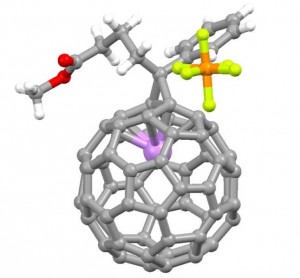A new material for organic solar cell research Chemical modification of lithium ion-encapsulated fullerene

Fullerene (C60), a cage molecule shaped like a soccer ball, has attracted much interest because of its potential application to next-generation solar cells, organic thin-film photovoltaic devices. Prof. Yutaka Matsuo and Dr. Hiroshi Okada in the University of Tokyo’s Graduate School of Science, succeeded for the first time in the chemical functionalization of a lithium ion-encapsulated fullerene, and developed a novel organic electronic material, lithium-ion-encapsulated PCBM (PCBM is a fullerene derivative, [6,6]-phenyl-C61-butyric acid methyl ester, a standard fullerene derivative used in organic solar cells). This new compound has a high electron-accepting property, and is expected to be utilized in research for high-performance organic solar cells.
Press release (Japanese)
Paper
Yutaka Matsuo, Hiroshi Okada, Masashi Maruyama, Hiroyasu Sato, Hiromi Tobita, Yoshihiro Ono, Kenji Omote, Kazuhiko Kawachi, Yasuhiko Kasama,
“Covalently Chemical Modification of Lithium Ion-Encapsulated Fullerene: Synthesis and Characterization of [Li+@PCBM]PF6?”,
Organic Letters, Publication Date (Web): 2012/7/6, doi: 10.1021/ol301671n.
Article link








